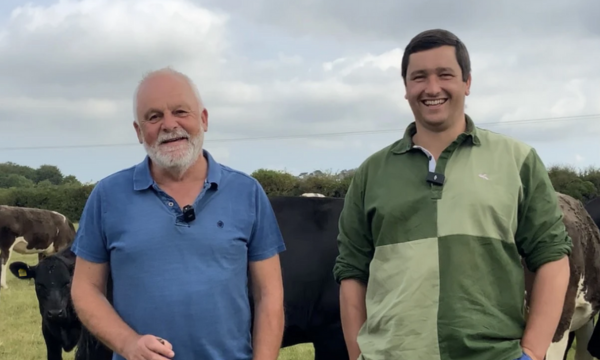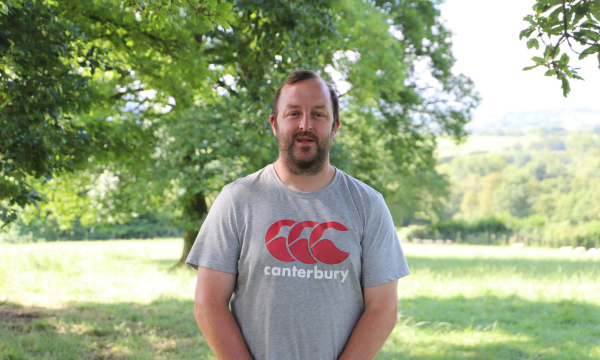
Technology can be a game-changer for improving efficiency across all farming systems. But a study undertaken on multiple dairy farms shows that by making improvements to existing practices, some Welsh farmers could make comparable labour-saving results without that investment.
A series of recent events run by Farming Connect on farms across Wales has also highlighted that the performance gains promised by agri-tech will differ in every farming situation.
From dairy and beef to sheep and poultry, Farming Connect has been working with farms to trial technology and assess their value in different systems.
This research and a study by Irish research body, Teagasc, has shown how technology can provide valuable solutions on some farms, but others can yield comparable results without that outlay.
Conor Hogan, People in Dairy Programme Manager at Teagasc Moorepark, told farmers attending the Farming Connect events that the situation for every farm is different but that efficiency improvements can often result from the cumulative impact of several small improvements rather than a single major change.
“It is the little things that can make a big difference, in the structuring of the day or how a milking parlour is manned, each saving time,’’ he said.
“Technology has a big role to play in agriculture going forward and for many farmers it will provide a solution to reduce workload and make work easier, but they should first consider what smaller adjustments they could make on the farm to make it more efficient.’’
1. Restructuring the working day
The Teagasc study involved 90 dairy farms and it demonstrated big differences in the ratios of the number of hours worked per cow – at one end of the scale a farm averaged 23.8 hours/cow/year and at the other it was 38.9 hours/cow/year.
That disparity adds up to 2,000 hours a year which, costed at a labour time of £15 an hour, is worth £34,000.
“These were similar farms in terms of scale, land type and structure, the only difference was their time input, and this shows that it does have a big impact on the bottom line,’’ said Conor.
The farmers who worked the fewest hours structured their day with a defined sequence of jobs but for the others it was more fragmented and haphazard and this resulted in a longer working day.
Conor said it indicated the very real benefits that could be gained in farm profitability and the quality of life of farmers and their staff if tasks were done in a structured way.
2. Streamlining the milking process
Milking can account for the task that requires the highest number of hours per day on a dairy farm so introducing changes here can make a big difference.
Conor says that from mid-lactation, the labour requirement in block-calving system with a parlour with 24-26 units should, with the right system, be achievable with one operator, yielding considerable cost savings.
Automatic cluster removal (ACR) can facilitate this and also good cow flow so that there is no requirement for the operator to leave the pit during milking; this can be achieved with automatic cow exit gates with a facility to operate these from anywhere in the pit.
It is where low-cost technology can be very beneficial – through use of a batt latch, for instance, to allow cows to come in earlier at their own pace to be milked.
3. Calf feeding and rearing
Calf rearing is where technology can have a very big positive effect on labour – Conor says farmers can expect a 20% increase in time efficiency with automatic feeders.
“They are very positive from a labour perspective but the system effect needs to be considered, if a farm is operating a really efficient rearing system the savings might not necessarily be seen.
“This needs to be weighed up on a farm-by-farm basis.’’
Penning calves in groups instead of individually will simplify the system with less need for manual cleaning, he added.
4. Good grazing infrastructure
From roadways and drinking water set-up to permanent fencing, infrastructure associated with grazing will simplify the system and reduce labour requirements.
“Every grazing farm should focus on its infrastructure first as it offers a rapid return,’’ Conor advised.
5. Consider where technology can deliver the best return on investment (ROI)
Once a farm has implemented efficiency improvements, it should consider how technology can deliver the best cost return.
There is a lot of positive data available on different innovations, said Conor. “They can maintain or do the tasks as well as any farmer.’’
But he added: “The ROI calculations on labour savings for many of them are less positive at the moment.’’
Their impact on productivity needs to be factored into the cost benefit equation too.
“They can be a suitable way of maintaining performance but generally we are not seeing big productivity gains,’’ said Conor.
“On heat detection, for example, technology is as good as a good farmer but if the farmer is achieving six-week calving or has very positive conception rates, technology, such as collars or pedometers, is probably not going to improve on that.’’
The additional benefits of these, for cow health for example, can be difficult to calculate, he added.
“However, if you are preventing a case or two of mastitis then it suddenly makes the ROI that much quicker and positive.”
“If a farm is seeing positives in terms of fertility or extra detection of lameness or mastitis it does have potential to cut the ROI period very quickly and if there is grant aid that period can be much quicker again.’’
Conor emphasised the importance of ensuring technology is a good fit for the farming system, its layout and scale, and management style.
“Technology will give you more access to data but is that something you will utilise?’’ he put to farmers.
He advised considering ease of use and training, whether the supplier offers support with these; looking at the cost structure, whether there is a capital outlay or a subscription model, and taking account of maintenance requirements, as well as considering if the technology can be integrated with a farm’s existing equipment.
“Using heat detection collars in conjunction with a drafting gate is a prime example,’’ said Conor.
Consider other benefits too, he advised.
“A positive with heat detection technology is the potential for longer AI periods and the possibility that allows for taking bulls out of the system, the impact that can have on genetic gain.’’
“Heat detection technology can be beneficial too if you are looking at using sexed semen or to adding more precision within the AI period.’’
The environmental benefits of some technologies cannot be overlooked either.
Farming Connect Carbon Specialist Officer Dr Non Williams says technology that can help farms become more efficient by improving animal health and boosting productivity has the potential to decrease greenhouse gas emissions produced per litre of milk or kilogramme of meat produced.
Precision agriculture techniques such as the use of GPS and sensors result in optimised use of resources and a reduction in waste on-farm. This may result in emission reductions if production is increased from less inputs.
New technologies such as biomethane-powered machinery are being trialled on farms too, and run on natural gas which can be collected and captured in slurry stores and anaerobic digester (AD) plants, she added, offering an environmentally-positive alternative to diesel.
Heat detection technology, such as collars, may also have secondary benefits, said Non.
“If the use of collars can lead to improved reproductive efficiency, such as accurately identifying cows in heat, and therefore fertility gains on-farm, this can result in a reduced carbon footprint per unit of milk produced.’’
By establishing a dairy system with labour efficiencies built in, Rhodri Jones believes heat detection collars might not offer him the return on investment he initially thought they would because his system is simple and low cost.
Rhodri and his wife, Siwan, converted the beef and sheep farm owned by her family to dairy, milking 197 cows on 65ha.
A spring-calving system has been established and investment made in good grazing infrastructure including tracks and water.
At Penparc, Llanerfyl, around 13tDM/ha/year of grass is grown on the grazing platform. The family are now in their third season of milking, their crossbred herd producing an annual average milk yield per cow of 5,600 litres from 1.1 tonne of concentrates.
Rhodri, who hosted one of the Farming Connect events, said he had been considering cow collar technologies to further improve efficiency but reasoned that they would not offer improved fertility results to current good performance. However, he is keen to investigate the benefits such as a higher rate of return and labour savings that other technologies could offer, automatic calf feeders for example.
“It is important to be open to different technologies and how they can help us streamline the business and improve performance,’’ he said.












